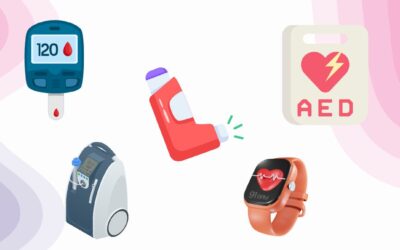Table of Contents
In the fast-paced world of medical technology, the lines between traditional medical devices and software applications are blurring. As a decision maker in the medical device industry, you understand the importance of compliance and quality assurance.
But what exactly constitutes software as a medical device (SaMD), and when does software cross the threshold into the realm of regulated medical devices?
Let’s dive into the intricacies of this evolving landscape and uncover key insights to keep your company ahead of the curve.
Defining Software as a Medical Device
The FDA’s definition of a medical device encompasses a wide array of instruments, machines, and contrivances intended for medical use. However, when it comes to software, the definition becomes more nuanced. SaMD refers to software that transforms non-medical platforms, such as mobile phones or PCs, into tools for medical diagnosis, treatment, or prevention.
This broad definition underscores the importance of understanding the intended use and impact of software applications within the medical field.
Whether it’s a mobile app for monitoring patient vital signs or a cloud-based platform for analyzing medical imaging data, any software with a medical purpose must adhere to regulatory standards to ensure patient safety and efficacy.
Regulatory Considerations and Exclusions of SaMD
Despite the expansive definition of medical devices, the FDA adopts a liberal approach to regulating software.
Certain categories, such as medical device data systems and clinical decision support software, are excluded from stringent regulations. These exemptions apply to low-risk software applications that do not involve complex medical data analysis or clinical decision-making.
However, recent interactions with the FDA highlight the need for clarity in determining the regulatory status of medical software.
In some cases, software developers have faced scrutiny from regulatory authorities questioning whether their products truly qualify as medical devices.
This underscores the importance of providing robust evidence to demonstrate compliance with regulatory standards and the intended medical purpose of the software. So, what does robust evidence entail?
- Documented Design Controls: Implement clear design controls throughout the software development lifecycle.
- Risk Management: Conduct thorough risk analysis and mitigation activities.
- Verification and Validation Testing: Perform rigorous testing to ensure the software functions as intended.
- Clinical Evaluation: If applicable, conduct clinical studies to assess safety and effectiveness.
- Quality Management System (QMS) Documentation: Maintain a robust QMS with documented procedures.
- Regulatory Submissions: Prepare and submit regulatory filings with comprehensive documentation.
- Post-Market Surveillance: Establish procedures for monitoring software performance and safety post-launch.
Bridging the Gap Between Software Development and Regulatory Compliance
One of the challenges in navigating the regulatory landscape for medical software lies in reconciling the differences between software development practices and traditional medical device regulations.
While software development is characterized by agility, iteration, and rapid deployment, regulatory compliance demands meticulous documentation, rigorous testing, and adherence to established standards.
To bridge this gap effectively, it’s essential to work with regulatory and quality consultants who possess expertise in both software development and medical device regulations. When selecting a consultant or partner for your quality and compliance program, inquire about their experience in managing quality systems for software and their understanding of global medical device regulations.
Determining Whether Your Product Qualifies as Software as a Medical Device (SaMD)
Are you wondering how to determine if your product falls under the category of Software as a Medical Device (SaMD)? Understanding the criteria is crucial, and both the FDA and the International Medical Device Regulators Forum (IMDRF) provide guidelines for identifying SaMD.
First, let’s address the fundamental question: does your software qualify as a medical device?
The IMDRF specifies that it must be “intended for one or more medical purposes”. Meanwhile, the FDA refers to Section 201(h) of the FD&C Act, which defines a device as:
Any instrument, apparatus, implement, machine, contrivance, implant, in vitro reagent, or related article, recognized in official compendia and intended for use in diagnosis, treatment, or prevention of disease, or to affect the structure or function of the body, not primarily through chemical action, and not dependent on metabolism.
Now that we have a definition to work from, let’s talk intended use
To apply this definition effectively, we need to define your product’s intended use and indications for use:
- Intended use: This refers to the purpose of your device, clarifying what it will be used for.
- Indications for use: These specify the diseases or conditions your device will diagnose, treat, prevent, cure, or mitigate, indicating who it will be used on and why.
Breaking down these uses will help you figure out if your product fits the FDA’s definition of a medical device.
If you plan to market your software product in the US, thorough understanding of FDA guidance on Policy for Device Software Functions and Mobile Medical Applications is important. This guidance describes which software functions the FDA considers medical devices, those it does not, and those it does not regulate as such.
However, if you are still unsure about your product’s classification, reaching out directly to the FDA is advised. Clarifying your product’s status ensures compliance and avoids potential regulatory issues down the line.
Know Better, Do Better – Taking Action to Ensure Regulatory Compliance for Your Medical Software
As they say, when you know better, you can do better. As you develop and deploy medical software, it’s crucial to prioritize regulatory compliance from the outset. Here are actionable steps to help you ensure regulatory compliance:
- Educate Yourself: Familiarize yourself with the FDA’s regulations and guidelines pertaining to medical software, including the criteria for determining SaMD status.
- Document Everything: Maintain thorough documentation throughout the software development lifecycle, ensuring traceability and compliance with regulatory requirements.
- Stay Informed: Keep abreast of developments in the regulatory landscape, including updates to regulations, guidelines, and enforcement priorities.
- Seek Expert Guidance: Not sure where to start or where your gaps are? Partner with regulatory and quality consultants who specialize in software as a medical device and have a proven track record of success in the industry.
Navigating the Complexities of SaMD Regulation
In the fast-paced world of medical tech, software is becoming increasingly important for diagnosing, treating, and caring for patients. It’s the behind-the-scenes hero, but it’s important to understand the ins and outs of how software fits into the medical device scene. This ensures that patients are safe, treatments are effective, and global standards are followed to a tee.
At Fission Consulting, we understand the unique challenges faced by software developers entering the medical device market. We have years of experience helping software firms tackle tricky global regulations and we’ve got your back. We’ll customize solutions to get you those ISO certifications and breeze through all the red tape with ease.
We’re not just about the rules, we’re all about making sure your software is top-notch. Our team brings together the best of both worlds: we know our stuff when it comes to software development, and we’re experts in all the regulatory nitty-gritty. Whether it’s planning your regulatory strategy, offering ongoing support, or helping with marketing, we’ve got you covered. We’re here to make sure your software is safe, effective, and totally compliant.
Contact us today to learn more about how Fission Consulting can support your journey to regulatory success in the dynamic world of medical software development. Let’s build the future of healthcare together, one compliant line of code at a time.



0 Comments